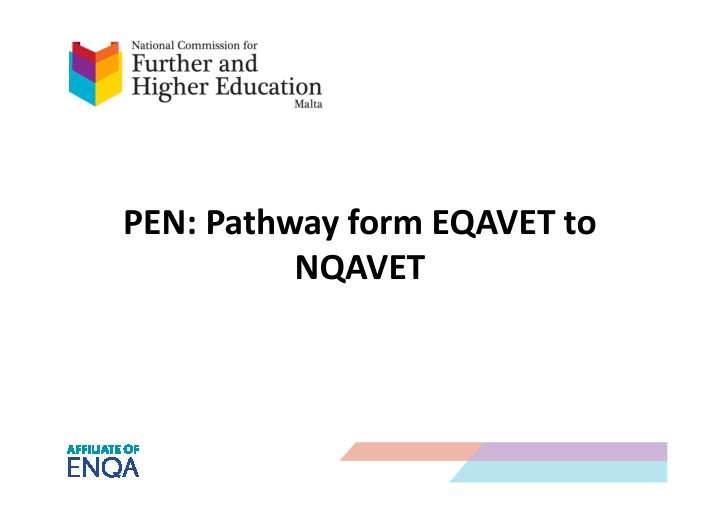



PEN: Pathway form EQAVET to NQAVET
Quality Assurance • Quality Assurance aims at safeguarding and improving the quality of teaching, learning, training and research within the economic, social and cultural context on a national, European and international level.
Why is QA important • Building trust • Transparency and efficiency • Create a trustworthy national education system, for the benefit of both national and international students by ensuring the portability of Maltese qualifications across European Member States fostering employment or learning mobility
What is The European Quality Assurance Reference Framework (EQAVET) ? • a reference instrument designed to help EU countries promote and monitor the continuous improvement of their VET systems on the basis of commonly agreed references • contribute to quality improvement in VET • building mutual trust between the VET systems • easier for a country to accept and recognise the skills and competencies acquired by learners in different countries and learning environments
The EQAVET Indicators Indicator 1: Quality assurance Indicator 2: Investment in training of teachers and trainers Indicator 3: Participation rate in VET programmes Indicator 4: Completion rate in VET programmes Indicator 5: Placement rate in VET programmes Indicator 6: Utilization of acquired skills at the workplace Indicator 7: Unemployment rate Indicator 8: Prevalence of vulnerable groups Indicator 9: Mechanism to identify the need of the labour market Indicator 10: Schemes used to promote better access to VET
Partner Organisations: • The coordinator Folkuniversitetet Uppsala (Sweden) • Beypazari District Directorate for Education (Turkey) • NCFHE (Malta) • University of Malta • Ministero dell’ Istruzione, dell’ Università e della Ricerca (Italy) • FACO (Denmark) • Tomsk State University (Russia ) • N.P.Pastuhov’s State Academy of Industrial Management (Russia)
Description of the project • Project «Pathway from EQAVET to NQAVET» - is the transition from the European to the national VET. It is associated with the development of a framework based on the European concept of professional qualifications and methods of forming cross-border system of certification of professional qualifications. • It aims to contribute to the definition and development of quality initiatives in vocational education and training. • Making European vocational education and training globally competitive
• Ensure high quality teaching, • Provide adequate initial teacher education, • Continuous professional development for teachers and trainers • Make teaching an attractive career –choice • Improve the quality, attractiveness and accessibility of the opportunities for lifelong learning • The elaboration of NQAVET guidelines for VET- institutes will promote and facilitate joint use of the European Quality Assurance Reference Framework for VET
Aims of the project 1) Develop national guidelines/recommendations regarding Quality in VET based on EQAVET in 4 pilot EU countries by national and regional authorities by: a) adapting and/or developing an approach to the EQAVET Recommendation which is fit for purpose and tailored to national needs and requirements, promoting the development of a culture of quality improvement b) elaborating adequate operational measures to implement the EQAVET recommendation and developing national Quality Assurance Frameworks (NQAF) for VET
Aims of the project 2) Elaborate recommendation for VET authorities (national / regional) based on experiences from the above pilots to support countries in their effort to develop of their own national quality guideline/recommendations for VET based on EQAVET.
Output • Results will be used and implemented by a range of stakeholders, specifically: – National agencies involved in VET and continuous VET – Policy makers at a local, regional, national and European Level – VET providers (leadership and teaching staff) – Lifelong learning Institutes.
THANK YOU angelique.grech@gov.mt
Recommend
More recommend